Predicting Perceived Restorativeness of Urban Streetscapes Using Semantic Segmentation and Machine Learning: A Case Study of Liwan District, Guangzhou
Abstract
1. Introduction
2. Research Design and Methodology
2.1. Research Area
2.2. Research Framework Overview
- (1)
- Data Acquisition and Processing
- (2)
- Perceptual Annotation and Scoring
- (3)
- Restorative Perception Prediction and Mapping
2.3. Data Acquisition and Processing
2.3.1. Street-View Collection
2.3.2. Semantic Segmentation
2.3.3. Visual Feature Derivation
- (1)
- Greenness
- (2)
- Openness
- (3)
- Enclosure
- (4)
- Walkability
- (5)
- Imageability
2.4. Perceptual Annotation and Scoring
2.5. Restorative Perception Prediction and Mapping
2.5.1. Machine Learning Modeling
2.5.2. Predictive Scoring and Classification
3. Results
3.1. Verification of the Reliability of Questionnaire Data
3.2. Performance Evaluation of Random Forest Model
3.3. Restorative Perception Predicts Spatial Distribution
3.4. Perception Clustering Partition Analysis
4. Discussion
4.1. The Relationship Between Restorative Perception and the Characteristics of Street Space
4.2. Method Advantages
4.3. Enhancing Urban Renewal: Psychological Insights for Street Revitalization in Liwan District
4.4. Limitations and Improvement Directions
5. Conclusions
Author Contributions
Funding
Data Availability Statement
Conflicts of Interest
Appendix A
| Case | Valid | 263 | Cronbach’s alpha | 0.995 | |
| Exclued | 0 | Bartlett’s test of sphericity | Approx Chi-Square | 95628.36 | |
| Total | 263 | df | 11,476 | ||
| KMO of sampling adequacy | 0.931 | Sig. | 0.000 | ||
| PRS Dimensions | Professional (n = 164) Mean ± SD | Non-Professional (n = 99) Mean ± SD | Mean Diff (Prof-Non) | p | Cohen’s d (Hedges g) |
|---|---|---|---|---|---|
| Fascination | 2.80 ± 0.98 | 3.03 ± 0.70 | −0.23 | 0.03 | −0.26 |
| Being away | 2.82 ± 0.97 | 3.04 ± 0.71 | −0.22 | 0.037 | −0.25 |
| Compatibility | 2.82 ± 0.96 | 3.05 ± 0.71 | −0.23 | 0.025 | −0.26 |
| Extent | 2.83 ± 0.97 | 3.03 ± 0.73 | −0.2 | 0.064 | −0.22 |
| PRS Dimensions | Fascination | Being Away | Compatibility | Extent | |
|---|---|---|---|---|---|
| Visual Metrics | |||||
| Greenness | 0.632 ** | 0.702 ** | 0.707 ** | 0.708 ** | |
| Openness | −0.397 ** | −0.428 ** | −0.396 ** | −0.421 ** | |
| Enclosure | 0.356 ** | 0.385 ** | 0.348 ** | 0.371 ** | |
| Walkability | 0.555 ** | 0.612 ** | 0.598 ** | 0.605 ** | |
| Imageability | 0.214 ** | 0.227 ** | 0.196 ** | 0.211 ** | |
References
- Liu, R.; Neisch, P. Measuring the Effectiveness of Street Renewal Design: Insights from Visual Preference Surveys, Deep-Learning Technology, and Eye-Tracking Simulation Software. Landsc. Urban Plann. 2025, 256, 105291. [Google Scholar] [CrossRef]
- Ma, X.; Ma, C.; Wu, C.; Xi, Y.; Yang, R.; Peng, N.; Zhang, C.; Ren, F. Measuring Human Perceptions of Streetscapes to Better Inform Urban Renewal: A Perspective of Scene Semantic Parsing. Cities 2021, 110, 103086. [Google Scholar] [CrossRef]
- Dai, L.; Zheng, C.; Dong, Z.; Yao, Y.; Wang, R.; Zhang, X.; Ren, S.; Zhang, J.; Song, X.; Guan, Q. Analyzing the Correlation between Visual Space and Residents’ Psychology in Wuhan, China Using Street-View Images and Deep-Learning Technique. City Environ. Interact. 2021, 11, 100069. [Google Scholar] [CrossRef]
- Tang, J.; Long, Y. Measuring Visual Quality of Street Space and Its Temporal Variation: Methodology and Its Application in the Hutong Area in Beijing. Landsc. Urban Plann. 2019, 191, 103436. [Google Scholar] [CrossRef]
- Zhao, J.; Wu, J.; Wang, H. Characteristics of Urban Streets in Relation to Perceived Restorativeness. J. Expo. Sci. Environ. Epidemiol. 2020, 30, 309–319. [Google Scholar] [CrossRef]
- Kaplan, R.; Kaplan, S. The Experience of Nature: A Psychological Perspective; Cambridge University Press: Cambridge, UK, 1989. [Google Scholar]
- Rezvanipour, S.; Hassan, N.; Ghaffarianhoseini, A.; Danaee, M. Why Does the Perception of Street Matter? A Dimensional Analysis of Multisensory Social and Physical Attributes Shaping the Perception of Streets. Archit. Sci. Rev. 2021, 64, 359–373. [Google Scholar] [CrossRef]
- Lindal, P.J.; Hartig, T. Effects of Urban Street Vegetation on Judgments of Restoration Likelihood. Urban For. Urban Green. 2015, 14, 200–209. [Google Scholar] [CrossRef]
- Barros, P.; Mehta, V.; Brindley, P.; Zandieh, R. The Restorative Potential of Commercial Streets. Landsc. Res. 2021, 46, 1017–1037. [Google Scholar] [CrossRef]
- Messier, L. Complete Streets Meet Fragmented Policies: Sidewalks in 30 U.S. Cities. Cities 2025, 157, 105588. [Google Scholar] [CrossRef]
- Sarkar, C.; Webster, C.; Pryor, M.; Tang, D.; Melbourne, S.; Zhang, X.; Jianzheng, L. Exploring Associations between Urban Green, Street Design and Walking: Results from the Greater London Boroughs. Landsc. Urban Plann. 2015, 143, 112–125. [Google Scholar] [CrossRef]
- Pérez, K.; Palència, L.; López, M.J.; León-Gómez, B.B.; Puig-Ribera, A.; Gómez-Gutiérrez, A.; Nieuwenhuijsen, M.; Carrasco-Turigas, G.; Borrell, C. Environmental and Health Effects of the Barcelona Superblocks. BMC Public Health 2025, 25, 634. [Google Scholar] [CrossRef]
- Ma, Q.; Wei, X.; Ren, G. Street Design Guidelines and Urban Road System Improvement: From Traffic Volume to Space Quality. Transp. Res. Procedia 2025, 82, 3266–3282. [Google Scholar] [CrossRef]
- Wu, K.; Guo, Y.; Han, X. The Relationship Research between Restorative Perception, Local Attachment and Environmental Responsible Behavior of Urban Park Recreationists. Heliyon 2024, 10, e35214. [Google Scholar] [CrossRef]
- Prince, M.; Patel, V.; Saxena, S.; Maj, M.; Maselko, J.; Phillips, M.R.; Rahman, A. No Health without Mental Health. Lancet 2007, 370, 859–877. [Google Scholar] [CrossRef]
- Li, Q. Effect of Forest Bathing Trips on Human Immune Function. Environ. Health Prev. Med. 2010, 15, 9–17. [Google Scholar] [CrossRef]
- Chen, S.; Chen, Z.; Hong, J.; Zhuang, X.; Su, C.; Ding, Z. Exploring the Relationship between Audio–Visual Perception in Fuzhou Universities and College Students’ Attention Restoration Quality Using Machine Learning. Front. Psychol. 2025, 16, 1572426. [Google Scholar] [CrossRef]
- Liu, Q.; Wu, Y.; Xiao, Y.; Fu, W.; Zhuo, Z.; Van Den Bosch, C.C.K.; Huang, Q.; Lan, S. More Meaningful, More Restorative? Linking Local Landscape Characteristics and Place Attachment to Restorative Perceptions of Urban Park Visitors. Landsc. Urban Plann. 2020, 197, 103763. [Google Scholar] [CrossRef]
- Kang, N.; Bell, S.; Ward Thompson, C.; Zheng, M.; Xu, Z.; Sun, Z. Use of Urban Residential Community Parks for Stress Management during the COVID-19 Lockdown Period in China. Front. Psychol. 2022, 1, 816417. [Google Scholar] [CrossRef] [PubMed]
- Cui, Q.; Zhang, Y.; Yang, G.; Huang, Y.; Chen, Y. Analysing Gender Differences in the Perceived Safety from Street View Imagery. Int. J. Appl. Earth Obs. Geoinf. 2023, 124, 103537. [Google Scholar] [CrossRef]
- Chen, C.; Li, H.; Luo, W.; Xie, J.; Yao, J.; Wu, L.; Xia, Y. Predicting the Effect of Street Environment on Residents’ Mood States in Large Urban Areas Using Machine Learning and Street View Images. Sci. Total Environ. 2022, 816, 151605. [Google Scholar] [CrossRef] [PubMed]
- Li, P.; Xu, Y.; Liu, Z.; Jiang, H.; Liu, A. Evaluation and Optimization of Urban Street Spatial Quality Based on Street View Images and Machine Learning: A Case Study of the Jinan Old City. Buildings 2025, 15, 1408. [Google Scholar] [CrossRef]
- Casali, Y.; Aydin, N.Y.; Comes, T. Machine Learning for Spatial Analyses in Urban Areas: A Scoping Review. Sustain. Cities Soc. 2022, 85, 104050. [Google Scholar] [CrossRef]
- Zeng, Q.; Gong, Z.; Wu, S.; Zhuang, C.; Li, S. Measuring Cyclists’ Subjective Perceptions of the Street Riding Environment Using K-Means SMOTE-RF Model and Street View Imagery. Int. J. Appl. Earth Obs. Geoinf. 2024, 128, 103739. [Google Scholar] [CrossRef]
- Guangzhou Municipal Bureau of Statistics; Survey Office of the National Bureau of Statistics in Guangzhou. Guangzhou Statistical Yearbook 2024; China Statistics Press: Beijing, China, 2024. [Google Scholar]
- Cordts, M.; Omran, M.; Ramos, S.; Rehfeld, T.; Enzweiler, M.; Benenson, R.; Franke, U.; Roth, S.; Schiele, B. The Cityscapes Dataset for Semantic Urban Scene Understanding. In Proceedings of the IEEE Conference on Computer Vision and Pattern Recognition (CVPR), Las Vegas, NV, USA, 26 June–1 July 2016. [Google Scholar] [CrossRef]
- Lei, Y.; Li, Q.; Tian, J.; Hu, J.; Jiang, J. Measurement of Spatial Heterogeneity in Street Restorative Perceptions and Street Refinement Design. Sci. Rep. 2025, 15, 19388. [Google Scholar] [CrossRef] [PubMed]
- Vosough, S.A.; Bozkurt, M. Evaluating the Restorative Potential of Different Green Strategies in Streets. Adnan Menderes Üniv. Ziraat Fak. Derg. 2024, 21, 145–153. [Google Scholar] [CrossRef]
- Shach-Pinsly, D. Visual Openness and Visual Exposure Analysis Models Used as Evaluation Tools during the Urban Design Development Process. J. Urban. 2010, 3, 161–184. [Google Scholar] [CrossRef]
- Zhao, J.; Guo, Q. Intelligent Assessment for Visual Quality of Streets: Exploration Based on Machine Learning and Large-Scale Street View Data. Sustainability 2022, 14, 8166. [Google Scholar] [CrossRef]
- Zhang, L.; Ye, Y.; Zeng, W.; Chiaradia, A. A Systematic Measurement of Street Quality through Multi-Sourced Urban Data: A Human-Oriented Analysis. Int. J. Environ. Res. Public Health 2019, 16, 1782. [Google Scholar] [CrossRef]
- Wang, R.; Lu, Y.; Zhang, J.; Liu, P.; Yao, Y.; Liu, Y. The Relationship between Visual Enclosure for Neighbourhood Street Walkability and Elders’ Mental Health in China: Using Street View Images. J. Transp. Health 2019, 13, 90–102. [Google Scholar] [CrossRef]
- Lynch, K. The Image of the City; MIT Press: Cambridge, MA, USA, 1960. [Google Scholar]
- Guzman, L.A.; Arellana, J.; Castro, W.F. Desirable Streets for Pedestrians: Using a Street-Level Index to Assess Walkability. Transp. Res. Part D Transp. Environ. 2022, 111, 103462. [Google Scholar] [CrossRef]
- Ernawati, J. The Role of Complexity, Coherence, and Imageability on Visual Preference of Urban Street Scenes. IOP Conf. Ser. Earth Environ. Sci 2021, 764, 12033. [Google Scholar] [CrossRef]
- Lu, X.; Xu, J.; Lange, E.; Cao, J. Which Factors Enhance the Perceived Restorativeness of Streetscapes: Sound, Vision, or Their Combined Effects? Insights from Four Street Types in Nanjing, China. Land 2025, 14, 757. [Google Scholar] [CrossRef]
- Herzog, T.R.; Maguire, P.; Nebel, M.B. Assessing the restorative components of environments. J. Environ. Psychol. 2003, 23, 159–170. [Google Scholar] [CrossRef]
- Yin, Y.; Thwaites, K.; Shao, Y. Balancing Street Functionality and Restorative Benefit: Developing an Expectation–Current Approach to Street Design. Sustainability 2022, 14, 5736. [Google Scholar] [CrossRef]
- Li, X.; Zhang, C.; Li, W.; Ricard, R.; Meng, Q.; Zhang, W. Assessing Street-Level Urban Greenery Using Google Street View and a Modified Green View Index. Urban For. Urban Green. 2015, 14, 675–685. [Google Scholar] [CrossRef]
- Huang, X.; Han, C.; Ma, M. Visual Preferences for Outdoor Space along Commercial Pedestrian Streets under the Influence of Plant Characteristics. PLoS ONE 2022, 17, e0264482. [Google Scholar] [CrossRef]
- Abkar, M.; Kamal, M.S.; Maulan, S.; Mariapan, M.; Davoodi, S.R. Relationship between the preference and perceived restorative potential of urban landscapes. HortTechnology 2011, 21, 514–519. [Google Scholar] [CrossRef]
- Astbury, J.; Huddart, S.; Théoret, P. Making the Path as We Walk It: Changing Context and Strategy on Green Street. Can. J. Environ. Educ. 2009, 14, 158–178. [Google Scholar]
- Long, Y.; Liu, L. How Green Are the Streets? An Analysis for Central Areas of Chinese Cities Using Tencent Street View. PLoS ONE 2017, 12, e0171110. [Google Scholar]
- Asgarzadeh, M.; Lusk, A.; Koga, T.; Hirate, K. Measuring Oppressiveness of Streetscapes. Landsc. Urban Plann. 2012, 107, 1–11. [Google Scholar]
- Simpson, J.; Freeth, M.; Simpson, K.J.; Thwaites, K. Visual Engagement with Urban Street Edges: Insights Using Mobile Eye-Tracking. J. Urban. Int. Res. Placemaking Urban Sustain. 2019, 12, 259–278. [Google Scholar] [CrossRef]
- Basu, R.; Sevtsuk, A. How Do Street Attributes Affect Willingness-to-Walk? City-Wide Pedestrian Route Choice Analysis Using Big Data from Boston and San Francisco. Transp. Res. Part A Policy Pract. 2022, 163, 1–19. [Google Scholar] [CrossRef]
- Wang, S.; Li, A. Identify the Significant Landscape Characteristics for the Perceived Restorativeness of 8 Perceived Sensory Dimensions in Urban Green Space. Heliyon 2024, 10, e27925. [Google Scholar] [CrossRef]
- Cavalcante, A.; Mansouri, A.; Kacha, L.; Barros, A.K.; Takeuchi, Y.; Matsumoto, N.; Ohnishi, N. Measuring Streetscape Complexity Based on the Statistics of Local Contrast and Spatial Frequency. PLoS ONE 2014, 9, e87097. [Google Scholar] [CrossRef]
- Rui, J. Measuring Streetscape Perceptions from Driveways and Sidewalks to Inform Pedestrian-Oriented Street Renewal in Düsseldorf. Cities 2023, 141, 104472. [Google Scholar] [CrossRef]
- Danish, M.; Labib, S.M.; Ricker, B.; Helbich, M. A Citizen Science Toolkit to Collect Human Perceptions of Urban Environments Using Open Street View Images. Comput. Environ. Urban Syst. 2025, 116, 102207. [Google Scholar] [CrossRef]
- Ogawa, Y.; Oki, T.; Zhao, C.; Sekimoto, Y.; Shimizu, C. Evaluating the Subjective Perceptions of Streetscapes Using Street-View Images. Landsc. Urban Plann. 2024, 247, 105073. [Google Scholar] [CrossRef]
- Zhang, T.; Wang, L.; Zhang, Y.; Hu, Y.; Zhang, W. Assessing the nonlinear impact of green space exposure on psychological stress perception using machine learning and street view images. Front. Public Health 2024, 12, 1402536. [Google Scholar] [CrossRef]
- Zhang, T.; Wang, L.; Hu, Y.; Zhang, W.; Liu, Y. Measuring Urban Green Space Exposure Based on Street View Images and Machine Learning. Forests 2024, 15, 655. [Google Scholar] [CrossRef]
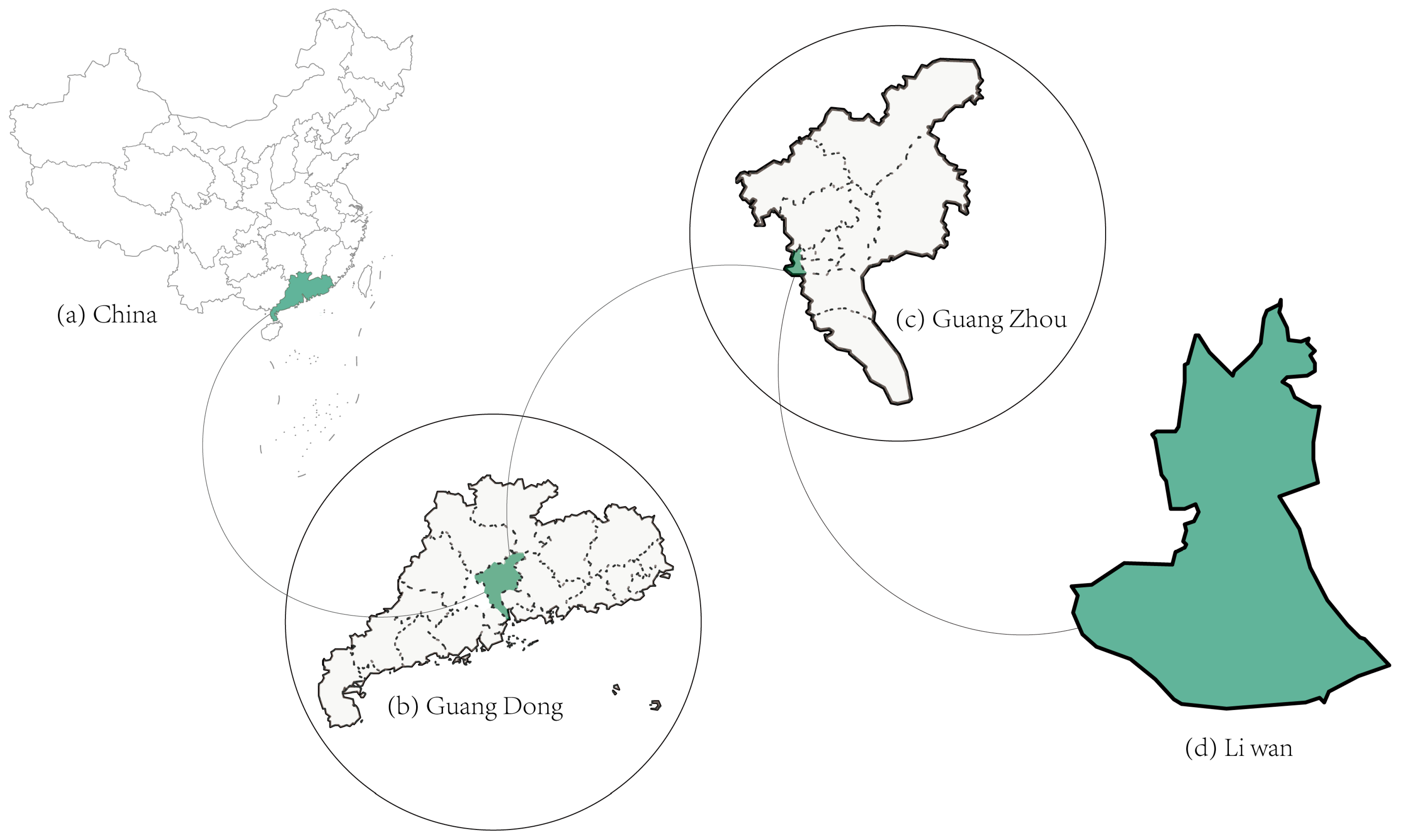
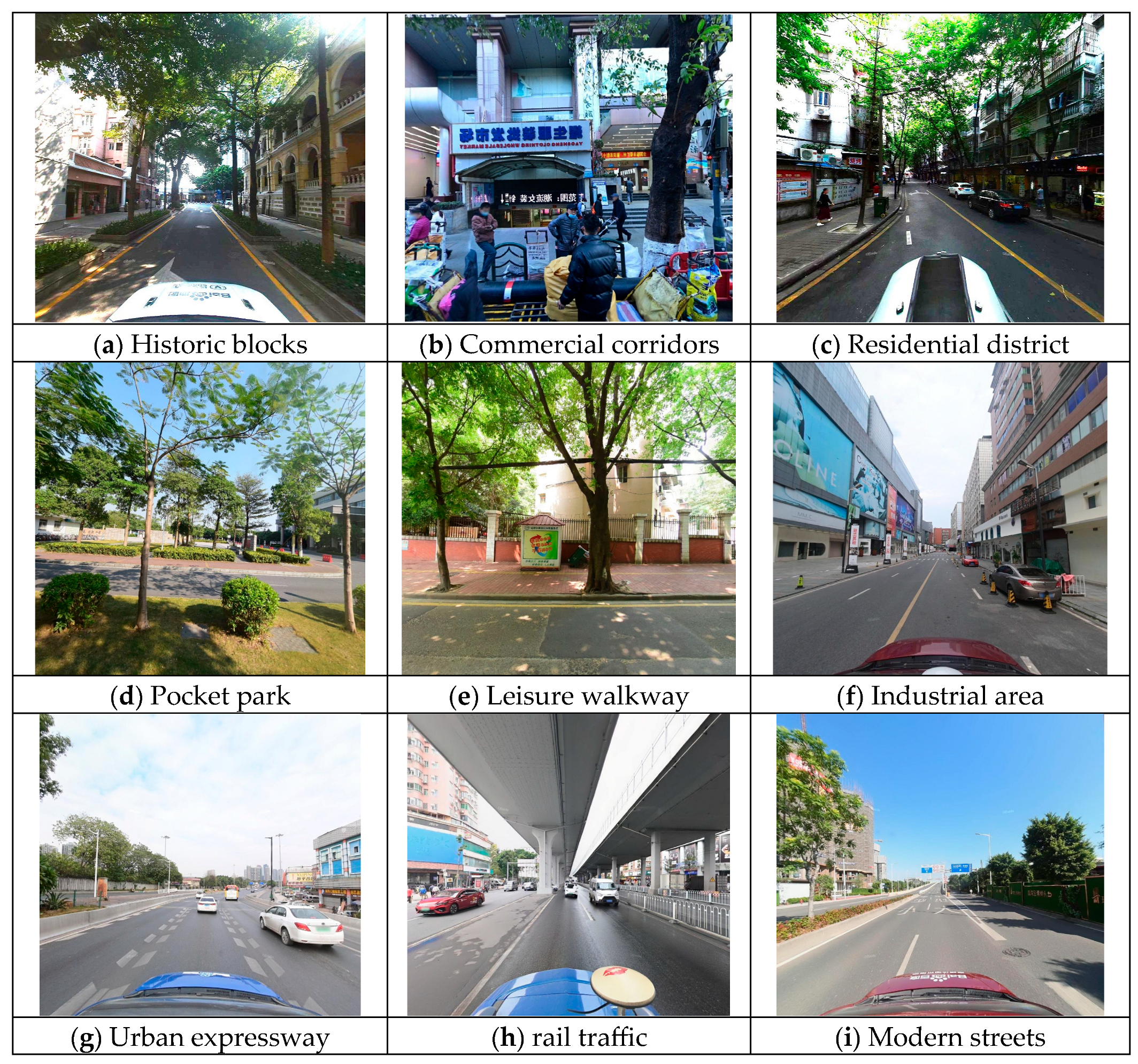
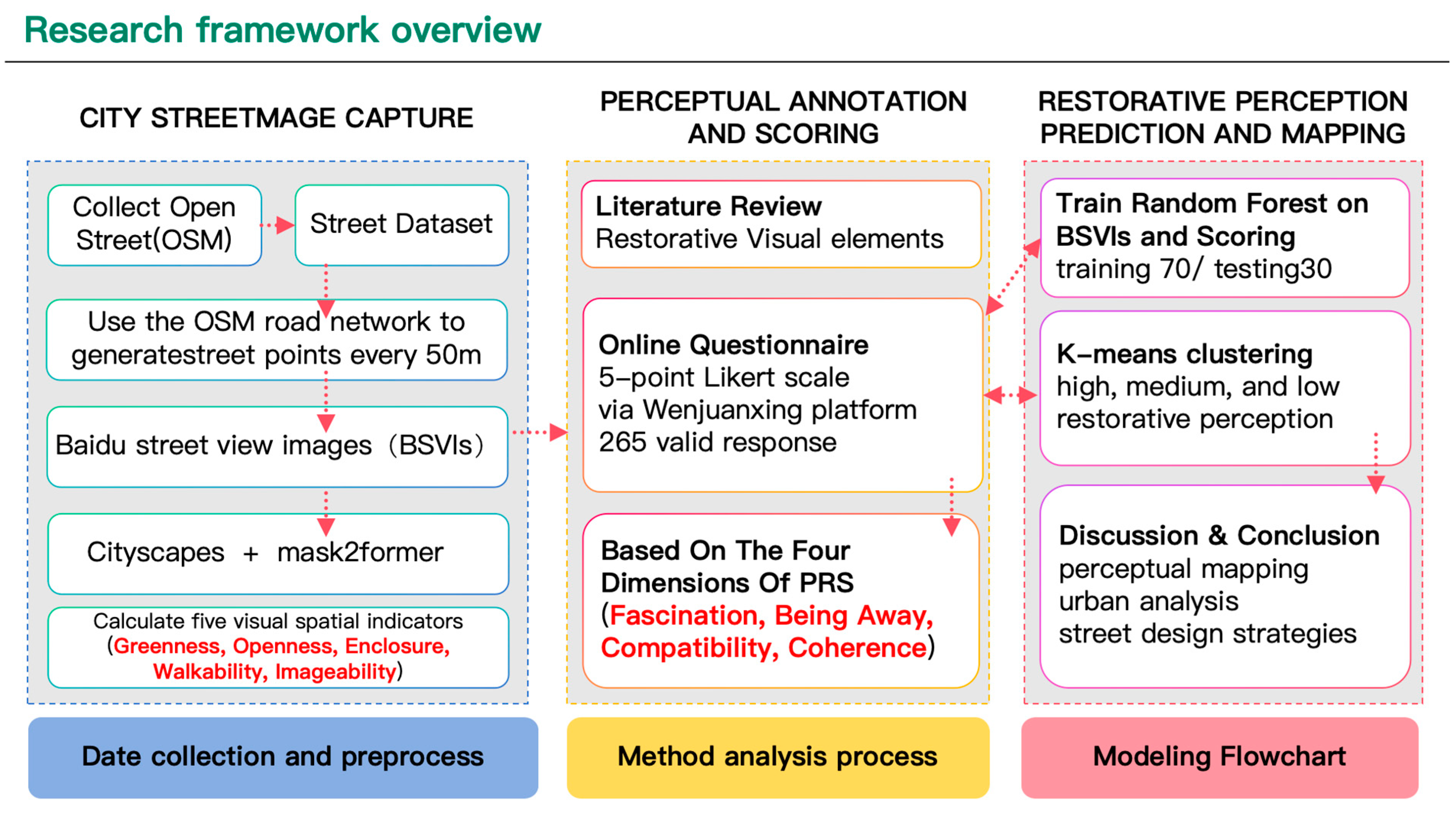

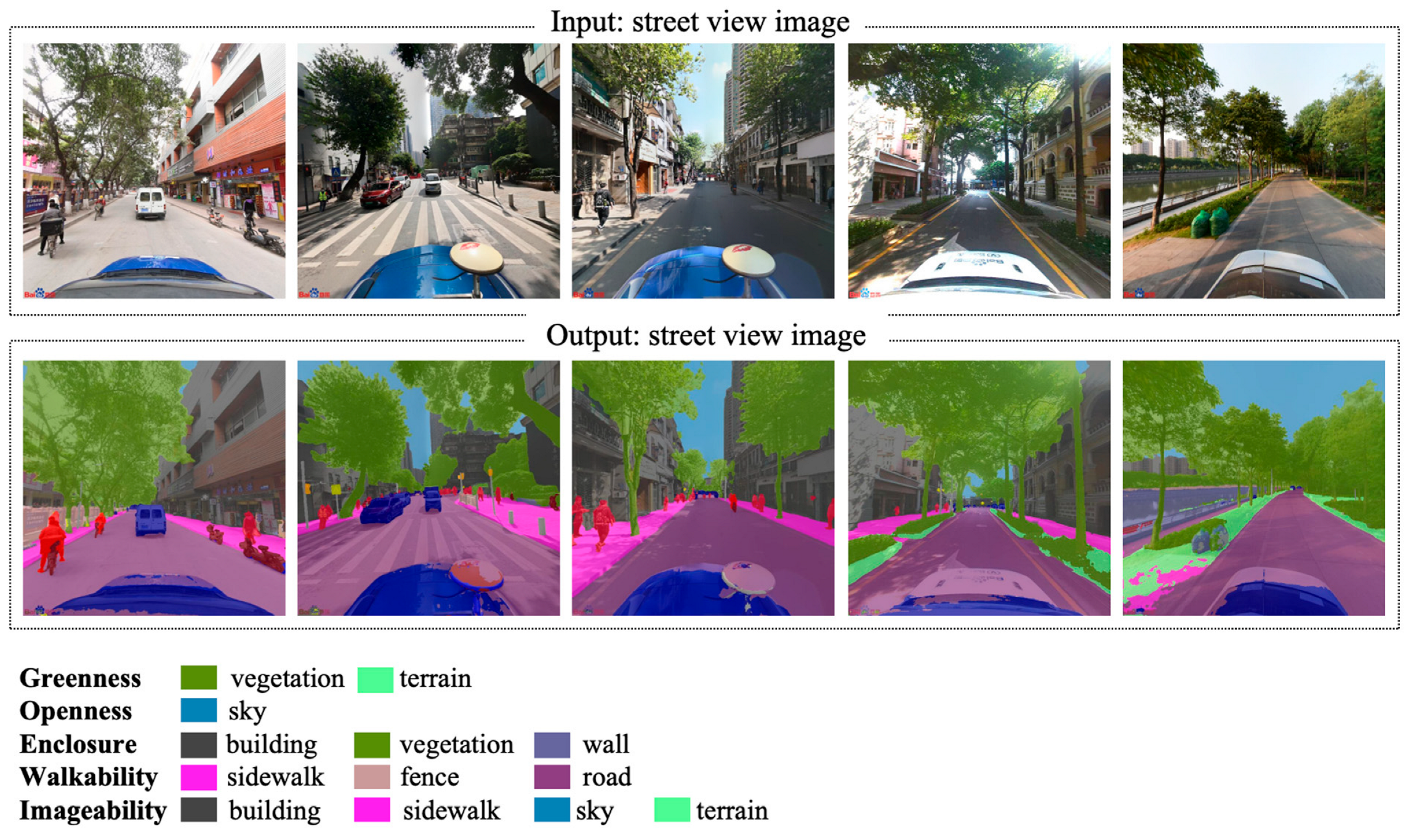
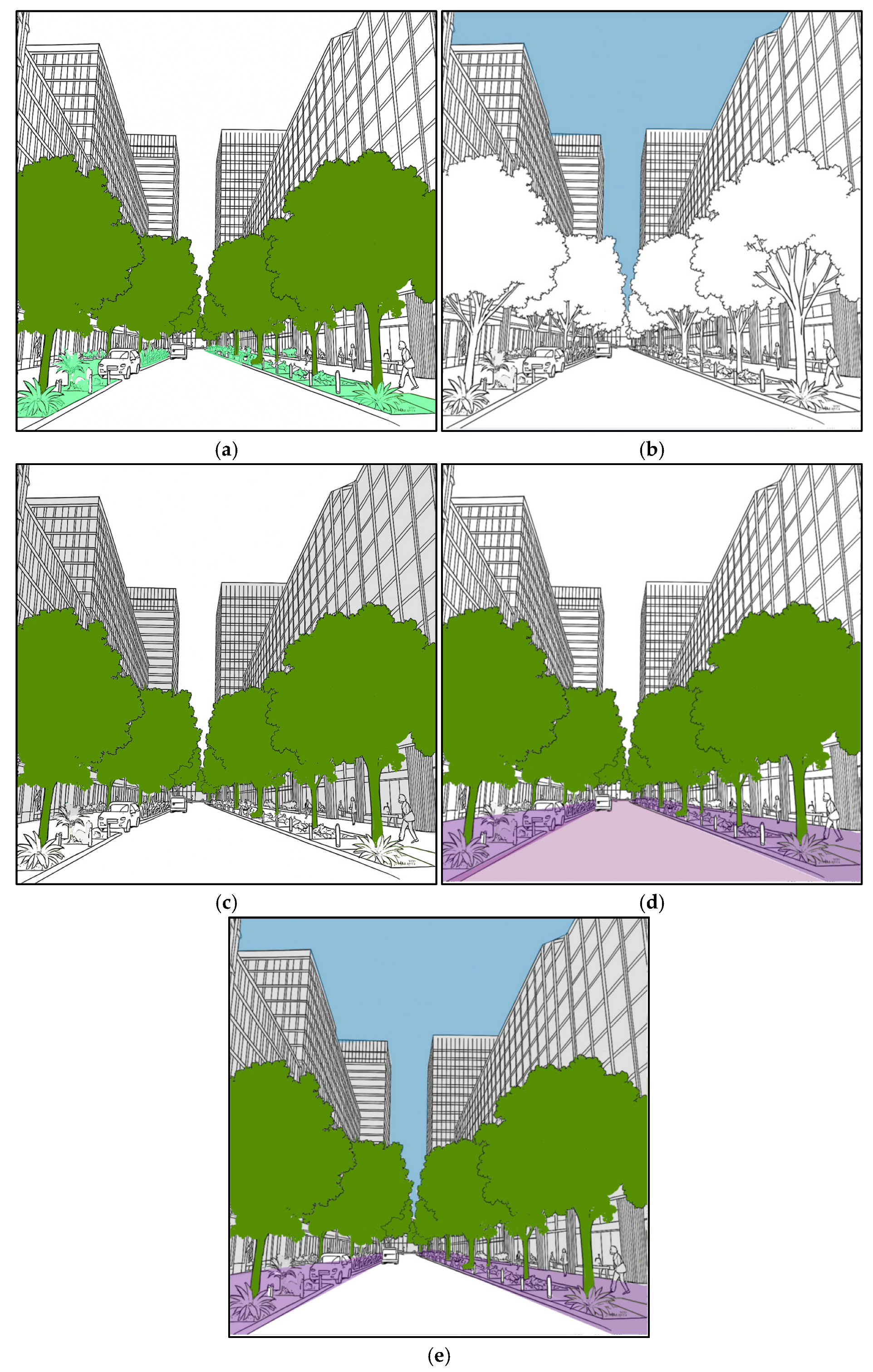
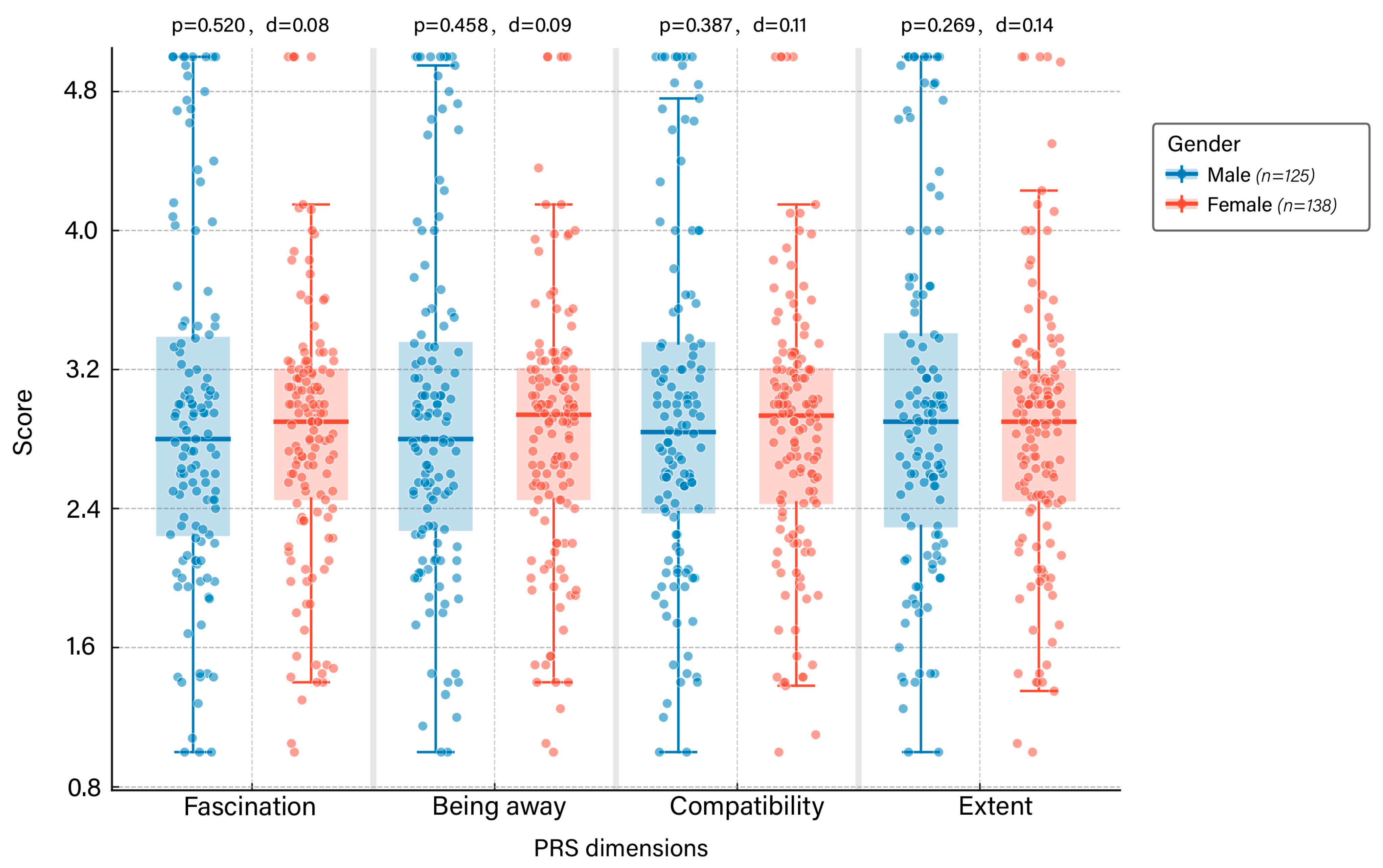
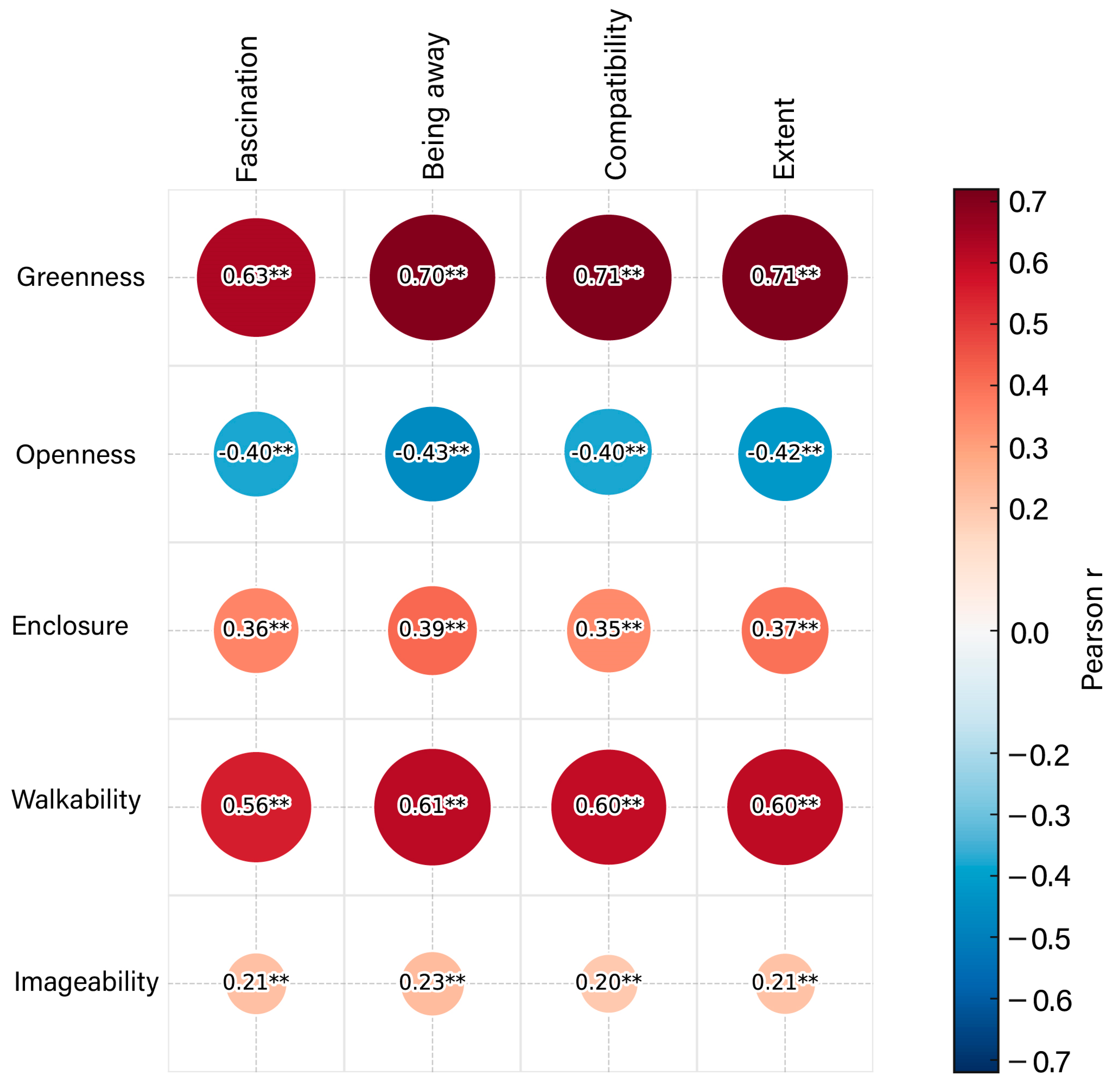

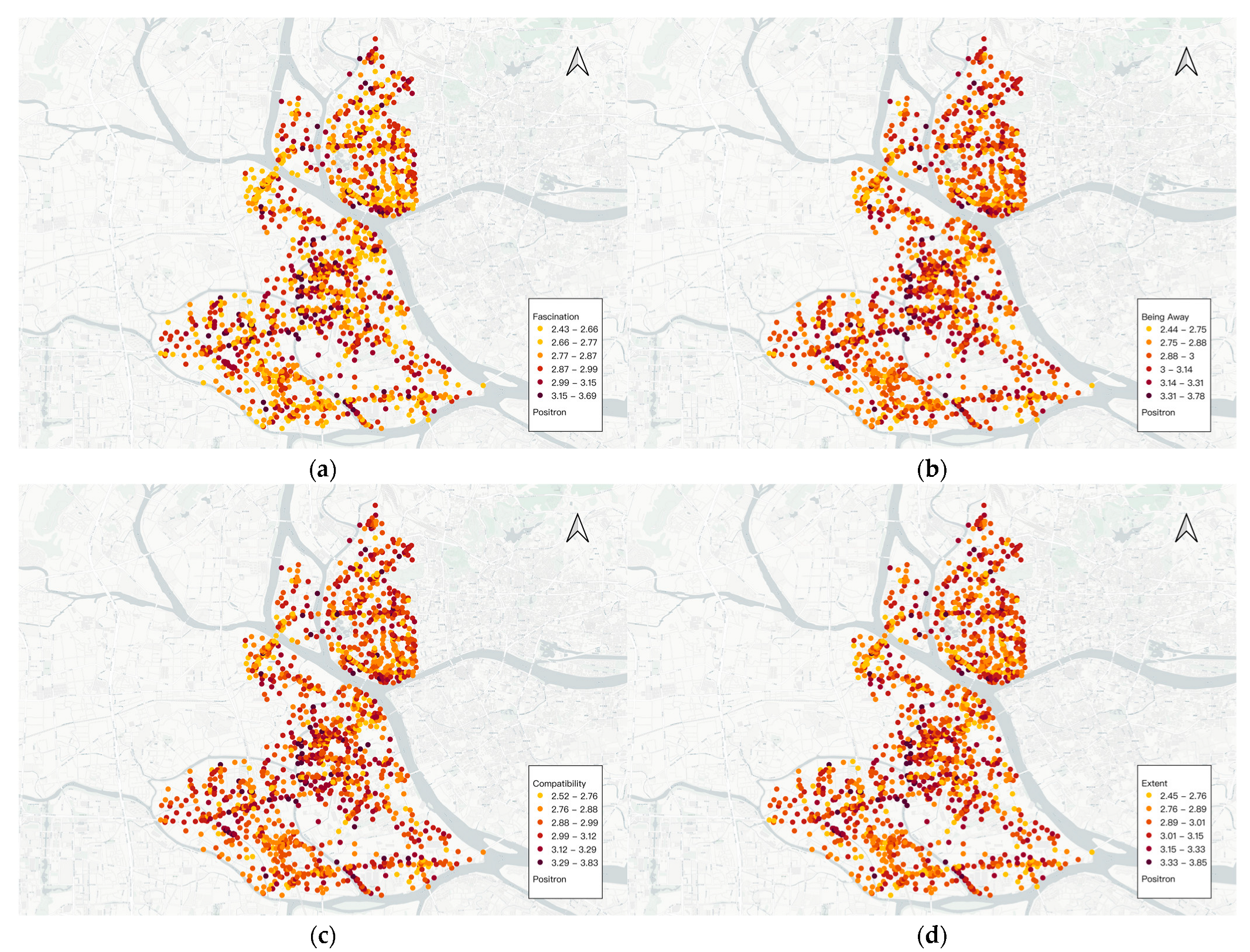
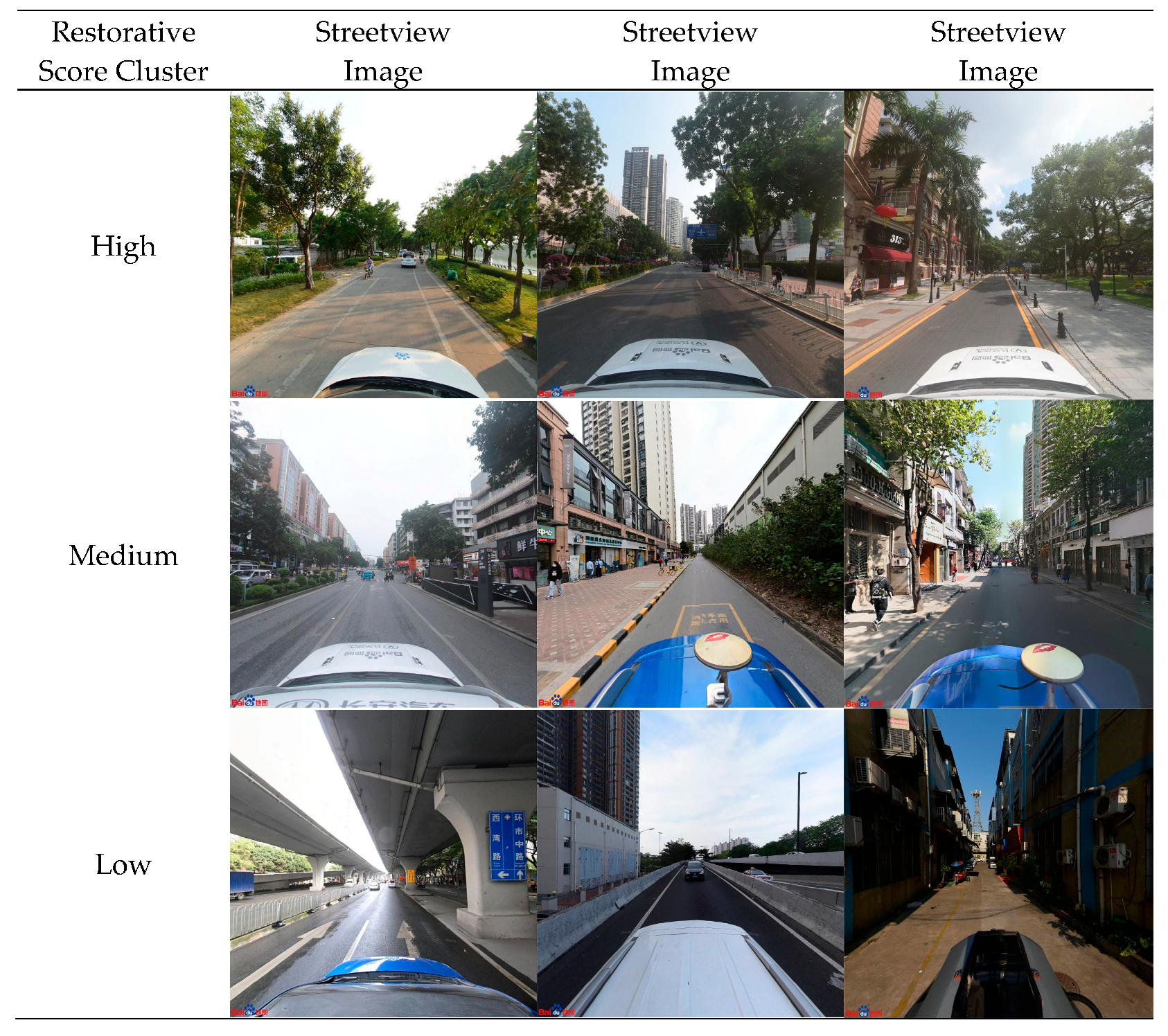
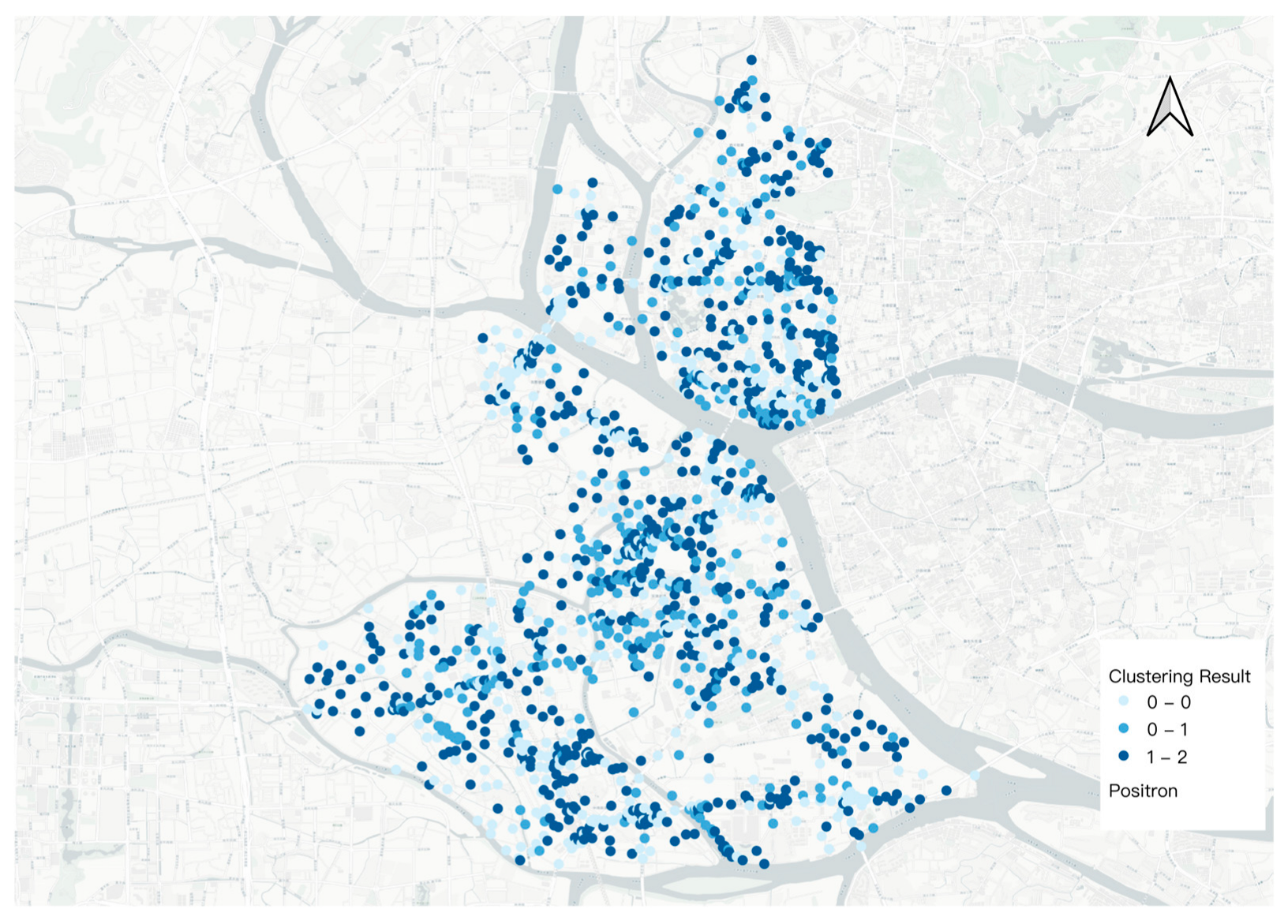
| Indicator | Formula | Formula Explanation |
|---|---|---|
| Greenness | denotes the percentage of Vegetation pixels; denotes the percentage of Terrain pixels; the sum indicates the total number of green pixels in each image. | |
| Openness | denotes the percentage of sky pixels. The sum indicates the total number of sky pixels in each image. | |
| Enclosure | denotes the percentage of building pixels. is the percentage of Vegetation pixels. is the percentage of Wall pixels. The sum indicates building, vegetation coverage and wall from four directions. | |
| Walkability | denotes the percentage of sidewalk pixels; denotes the percentage of Terrain pixels; denotes the percentage of Vegetation pixels. denotes the percentage of road pixels. The equation quantifies walkability by measuring the visual proportion of sidewalks, fences and vegetation coverage relative to roads. | |
| Imageability | denotes the percentage of building pixels. denotes the percentage of sidewalk pixels. denotes the percentage of sky pixels. denotes the percentage of Vegetation pixels. The equation reflects the imageability of streets, highlighting building, natural elements, and visible public features contribute to the richness and diversity of the street scene. |
| Dimensions | PRS Statement |
|---|---|
| Fascination (F) | F1—I find this streetscape very attractive. F2—I would like to spend more time appreciating the scenery here. |
| Being away (B) | B1—This streetscape helps me relax my mind. B2—This streetscape allows me to temporarily escape from daily stress. |
| Compatibility (C) | C1—This streetscape fits my aesthetic preferences. C2—I enjoy being active in this visual environment. |
| Extent (E) | E1—This streetscape gives me a sense of freedom and lack of constraint. E2—This streetscape inspires many positive thoughts in me. |
| Category | Number | Percentage/% | |
|---|---|---|---|
| Gender | Male | 125 | 47.5 |
| Female | 138 | 52.5 | |
| Age | Below 18 | 2 | 0.8 |
| 18–25 | 123 | 46.8 | |
| 26–30 | 17 | 6.5 | |
| 31–40 | 65 | 24.7 | |
| 41–50 | 33 | 12.5 | |
| 51–60 | 9 | 3.4 | |
| Above 60 | 14 | 5.3 | |
| Relevant industry | Yes | 164 | 62.4 |
| No | 99 | 37.6 | |
| Fascination | Being Away | Compatibility | Extent | |||||
|---|---|---|---|---|---|---|---|---|
| t | p | t | p | t | p | t | p | |
| Greenness | 13.391 | 0.000 ** | 16.923 | 0.000 ** | 18.562 | 0.000 ** | 18.126 | 0.000 ** |
| Openness | −8.829 | 0.000 ** | −9.801 | 0.000 ** | −9.23 | 0.000 ** | −10.168 | 0.000 ** |
| Enclosure | −6.14 | 0.000 ** | −6.711 | 0.000 ** | −6.75 | 0.000 ** | −7.166 | 0.000 ** |
| Walkability | 2.091 | 0.037 * | 2.063 | 0.039 * | 0.816 | 0.415 | 1.247 | 0.213 |
| Imageability | 4.526 | 0.000 ** | 4.73 | 0.000 ** | 4.188 | 0.000 ** | 4.675 | 0.000 ** |
| R2 | 0.442 | 0.537 | 0.533 | 0.544 | ||||
| F | 239.181, p = 0.000 | 349.867, p = 0.000 | 344.355, p = 0.000 | 360.174, p = 0.000 | ||||
| Indicators | Visual Elements | Max | Min | Mean | S.D. |
|---|---|---|---|---|---|
| segmentation visual elements | road | 0.450 | 0.040 | 0.248 | 0.075 |
| building | 0.780 | 0.000 | 0.199 | 0.160 | |
| vegetation | 0.700 | 0.000 | 0.195 | 0.143 | |
| sky | 0.520 | 0.000 | 0.182 | 0.130 | |
| sidewalk | 0.170 | 0.000 | 0.030 | 0.030 | |
| fence | 0.210 | 0.000 | 0.022 | 0.029 | |
| wall | 0.340 | 0.000 | 0.022 | 0.037 | |
| terrain | 0.300 | 0.000 | 0.013 | 0.028 | |
| Visual perception indices | Greenness | 0.750 | 0.000 | 0.208 | 0.152 |
| Openness | 0.520 | 0.000 | 0.182 | 0.130 | |
| Enclosure | 0.790 | 0.020 | 0.416 | 0.155 | |
| Walkability | 3.500 | 0.000 | 0.256 | 0.296 | |
| Imageability | 0.880 | 0.320 | 0.606 | 0.074 |
Disclaimer/Publisher’s Note: The statements, opinions and data contained in all publications are solely those of the individual author(s) and contributor(s) and not of MDPI and/or the editor(s). MDPI and/or the editor(s) disclaim responsibility for any injury to people or property resulting from any ideas, methods, instructions or products referred to in the content. |
© 2025 by the authors. Licensee MDPI, Basel, Switzerland. This article is an open access article distributed under the terms and conditions of the Creative Commons Attribution (CC BY) license (https://creativecommons.org/licenses/by/4.0/).
Share and Cite
Kang, W.; Kang, N.; Wang, P. Predicting Perceived Restorativeness of Urban Streetscapes Using Semantic Segmentation and Machine Learning: A Case Study of Liwan District, Guangzhou. Buildings 2025, 15, 3671. https://doi.org/10.3390/buildings15203671
Kang W, Kang N, Wang P. Predicting Perceived Restorativeness of Urban Streetscapes Using Semantic Segmentation and Machine Learning: A Case Study of Liwan District, Guangzhou. Buildings. 2025; 15(20):3671. https://doi.org/10.3390/buildings15203671
Chicago/Turabian StyleKang, Wenjuan, Ni Kang, and Pohsun Wang. 2025. "Predicting Perceived Restorativeness of Urban Streetscapes Using Semantic Segmentation and Machine Learning: A Case Study of Liwan District, Guangzhou" Buildings 15, no. 20: 3671. https://doi.org/10.3390/buildings15203671
APA StyleKang, W., Kang, N., & Wang, P. (2025). Predicting Perceived Restorativeness of Urban Streetscapes Using Semantic Segmentation and Machine Learning: A Case Study of Liwan District, Guangzhou. Buildings, 15(20), 3671. https://doi.org/10.3390/buildings15203671








